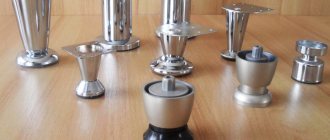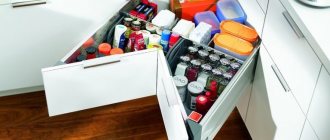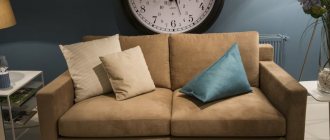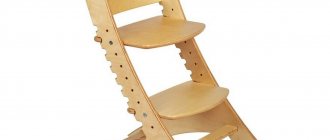Wooden furniture itself is quite expensive, because... The manufacturing material is environmentally friendly. But despite a bunch of positive properties, it is subject to various deformations when exposed to a variety of negative external factors. Thus, in order to prevent the influence of such processes on the wood base, care should be taken to prevent them in a timely manner. Various fixing varnishes for furniture can serve as an excellent tool in this regard.
Furniture fixing varnish is a substance (or mixture thereof) that has film-forming characteristics and is applied to the wooden surface of the furniture. Its main purpose is to provide the wooden base with a special film that will protect it from the effects of negative external factors, while simultaneously maintaining the internal structure of the integrity of the tree. Applying a varnish coating can be either the final stage in the manufacture of furniture or one of the stages of the repair process. Products can be produced in the form of sprays or liquid mixtures for application with a brush/roller.
Existing types of fixing compounds
Fixing varnish, unlike paint, is not intended to hide the natural pattern of wood, but should “fix” its quality properties at the original level. Thus, it must protect the surface of the furniture from moisture, the harmful effects of UV rays, mechanical shocks and the occurrence of roughness. Not all fixing varnishes are suitable for use at home, so you should clearly understand their varieties in order to obtain the most effective result. According to the direction of fixing properties, the varnish coatings under consideration can be divided into:
- Water-repellent - maintains the integrity of the wood base when interacting with moisture;
- Weather-resistant - resist natural precipitation and phenomena (for example, gusty winds, which eventually weaken the surface);
- Heat-resistant – resist thermal stress;
- Impact-resistant - protect the structure from mechanical damage.
How is detarring carried out?
A special feature of pine is the presence of a large amount of resinous substances, which does not always allow paint or varnish to lie flat, so the wood must be deresined before applying the coating. Also, when a large amount of resin accumulates in a certain area, it darkens and spoils the appearance of the furniture. In addition, a sticky film appears that will prevent the primer from absorbing. This procedure involves the complete or partial removal of resinous substances. To do this, use a special solvent-based composition. It is applied with a brush, then the surface is washed and dried. If the tarred areas have a large area, then they are cut out with a knife and sealed with putty. The solvent may contain components such as:
- technical solution of acetone;
- baking soda;
- technical alcohol;
- potash;
- hot water;
- soap flakes.
Functional Features
As a rule, fixing coatings are some combination of a special film-forming substance with an organic solvent. After drying, the surface of the furniture is covered with a transparent layer, and it can be given shades of matte/glossy shine. All the protective characteristics of the varnish will depend on its composition, in other words, its variety. With the help of the substances in question, furniture can be transformed and retain its original qualities for a long time, whether it is assembled from MDF or chipboard, plywood or wood. Basically, fixing varnishes are designed to perform the following functions:
- Adding a special shine to surfaces;
- Protection from pests, water and dirt;
- Preservation of color qualities;
- Giving furniture strength and durability;
- Resists swelling/cracking over time;
- Resistance to conditions of elevated temperatures, various atmospheric aggressive factors;
- Masking of some surface defects (hiding small chips, scratches or cracks);
- Preventing accidental injury to people (eg eliminating the risk of splinters).
Best lists
Don’t limit yourself to a small rating; let’s get to know the best in the following categories:
- Water.
- Polyurethane.
- For decoupage.
Now let's move on to the description. The section will describe one model, including descriptions, parameters and price in the middle range.
Water
TURY has a wide range of applications. Used as a coating for furniture and floors. The total drying time is 6 hours. The next step is to apply a new layer if necessary. You can use any tools: roller, sprayer, brush.
| The basis | polyacrylic |
| Weight | 2 kg |
| Diluent | water |
| Gloss | semi-matte |
| Drying | 6 hours |
Price: from 450 to 600 rubles.
construction varnish TURY
Polyurethane
VGT Premium is diluted with water in order to be economical and increase the existing volume. It is safe and easy to use, making it suitable for most buyers. The complete drying time is a day. Does not have a specific color, with a high tendency to colorlessness.
| The basis | polyurethane |
| Weight | 2.2 kg |
| Gloss level | matte |
| Diluent | water |
Price: from 250 to 500 rubles.
construction varnish VGT
For decoupage
Poli-R is a varnish designed for parquet flooring, providing it with high strength and resistance to water. Diluting the product with water is prohibited, but it is strongly recommended to use a solvent, as when working with paint. After some time of drying, the varnish shines and gives the parquet a more presentable appearance.
| Volume | 0.75 l |
| The basis | alkyd-urethane |
| Diluent | solvent |
| Shine | glossy |
Price: from 400 to 550 rubles.
construction varnish Poli-R
Modern types of fixing varnishes
Oil based
A similar substance is designed to fix the appearance of wooden furniture, giving its surface a certain characteristic yellowish woody tint. The structure of the substance includes a solvent, various oils and resins. In the past, the composition included linseed oil, today synthetics are used. White spirit or turpentine may also be added. Characterized by a long drying process. The protective film formed is designed to prevent the appearance of fungus/mold, as well as fading in the sun. This coating is moisture-resistant and durable, as well as visually attractive. Great for treating garden furniture, fences or gazebos. In cases where processing is carried out in domestic conditions, it is necessary to pay attention to the presence of harmful/toxic substances in the composition and use protective equipment (respirator) during the process. Also, after hardening, the treated surface can be sanded, which will add additional shine.
Nitrocellulose base
The basis of this varnish is nitrocellulose. The composition contains resins and plasticizers, organic solvents and colloxylin. This substance can be used for repair work on furniture and is suitable for application to any type of wood. It is considered very safe and does not have an unpleasant odor. The drying process is very fast - within 45-60 minutes a hard film forms. The resulting coating has enhanced decorative properties and is considered the best means for fixing designs and decorations on a wooden surface. In addition, being quite durable and moisture-resistant, the varnish base can easily withstand polishing. However, it has a pronounced instability to the negative effects of the atmosphere. Hence the conclusion - this varnish is not intended for outdoor furniture. When performing processing, the use of protective equipment is required.
Water
Such varnishes are considered the most environmentally friendly and safe, because they contain absolutely no toxic substances. Recommended for processing children's furniture and furniture in medical institutions. After application, a coating is created on the surface that is characterized by increased strength and resistance to mechanical stress. Despite their water base, such varnishes are not able to withstand the effects of moisture - again, they are not recommended for outdoor furniture. They may contain one or two components. One-component ones do not require dilution or mixing with other substances (solvents), and the latter are produced using polyurethane, which increases their strength. The most popular means of fixation include water-based acrylic compounds. In its original form, this substance is white, but after application and drying, the water base evaporates, and the remaining resin forms a transparent layer. The main advantages of acrylic are:
- Complete security;
- No unpleasant odors;
- High level of fire safety;
- Quick drying;
- Preservation of the natural structure of wood;
- Increased strength.
However, such varnish should only be used in spaces where the ambient temperature is at least +20 degrees Celsius - otherwise the coating simply will not dry.
Polyurethane compounds
These include polyesters and isocyanates. Usually, they are performed on a water base, which makes it clear that they do not contain toxic substances. They are characterized by strength, moisture resistance, and elasticity, which extends their service life. The film is created with glossy shades, perfectly removes and resists chips and cracks. They can be used for wood of any species. They are excellent at resisting moisture, which makes such varnishes optimal for treating country furniture (gazebos, gardens, summer verandas, etc.). The polyurethane layer protects not only from water precipitation, but also from direct sunlight, as well as from temperature changes. However, there are a number of disadvantages:
- High price;
- Long drying period;
- During processing, a pungent odor is released.
Based on alkyd resins
Such varnish substances are created on the basis of synthetic resins and have the properties of strength, moisture resistance and transparency. They can be used on any type of wood and do not depend on the conditions under which the treatment is to be carried out. Perfect for covering country furniture. After hardening, the surface is covered with a transparent film that is resistant to negative atmospheric conditions. At the same time, the furniture acquires protection from mechanical damage and can withstand the destructive effects of some aggressive chemicals. The disadvantages of using alkyd varnish coatings include their long drying process - complete hardening of the substance occurs only 72 hours after treatment. Among other things, the product has a pungent odor, and the composition may contain toxic components - solvent, xylene, white spirit. The most durable example is considered to be an alkyd-urethane varnish, which can be used to cover not only furniture, but also parquet floors. Alkyd-urea products have a two-component composition and dry quickly.
Craquelure varnishes
This is a special varnish variety that is decorative and allows you to create the look of aged furniture. This sample can be used for working with antique objects. After the processing procedure, a surface with natural traces of cracking is formed. This effect becomes possible due to the fact that the coating and varnish have different drying periods. This option is used only when appropriate for interior design.
Purpose
Furniture items made of wood and particle boards are actively used in home and office interiors. Under the influence of external negative factors, products can become deformed, crack, or become moldy. To protect and prevent loss of attractive appearance, special furniture varnishes are used. The products have a film-forming property, which manifests itself after applying the composition to the surface of the furniture and its complete drying. The finished product is coated with varnish at the final stage of processing.
Furniture varnishes can have different shades, matte or glossy finish, but their coating remains transparent or translucent. This allows you not to hide, but, on the contrary, to emphasize the natural beauty of the wood structure.
Depending on the degree of gloss of the coating, the following types of product are distinguished:
- Matte furniture varnish is practical and does not show fingerprints or stains at all. Matte surfaces are appropriate in business and office premises; they are combined with chrome fittings;
- Glossy coatings have a maximum degree of light reflection. Furnishings with a glossy shine often become the main accents of the interior. They look noble and elegant;
- Semi-gloss and semi-matte varnishes are universal. They are suitable for decorating any furniture, have a moderate shine and do not show much hand marks;
- Some products are suitable for garden furniture; they are resistant to moisture and contain substances that protect against the negative effects of UV rays.
Matte
Glossy
Semi-gloss
Differences between fixing varnish and interior varnish
In order to most effectively use varnish for fixation, it is necessary to distinguish it from interior varnish and take into account the operating conditions of future objects of processing and the load on them. Although there are no big differences between fixing and interior varnishes, some manufacturers use the name “fixing” to emphasize the exclusive repair nature of the substance, as well as the fact that they are not recommended, for example, to cover parquet floors. As a result, fixing varnish coatings have the following main differences:
- Maximum permissible loads – application specifically to decorative pieces of furniture in order to preserve one or another of its designs/patterns, which does not imply intensive use of the object;
- The level of gloss is the frequent inclusion in the structure of the varnish of components that form a matte rather than glossy effect, because the former are less easily soiled and do not leave fingerprints;
- Operational options - for treating outdoor furniture, varnishes have in their structure mandatory components that resist negative atmospheric phenomena, temperature fluctuations and frequent changes in humidity;
- Shades – fixing substances can be either transparent or tinted. The latter are responsible for maintaining the color and even enhance it a little, however, the texture and pattern of the wood remain unchanged.
comparison table
Based on the rating compiled above, we organized the main technical parameters of varnishes and placed them in a table. With this organized information, you can track down the most suitable remedy for yourself.
| Name | Shine | The basis | Weight | Price, rub) |
| EUROTEX | semi-gloss | acrylic | 2.5 | 400 – 850 |
| TEX Pro | glossy | acrylic | 2.5 | 650 – 1 200 |
| VGT | glossy | acrylic | 3 | 350 – 700 |
| Dulux Diamond Glaze | glossy | acrylic-urethane | 0.9 | 480 – 650 |
| Tikkurila | glossy | acrylic | 2.7 | 500 – 680 |
| Parade | glossy | acrylic | 2.6 | 800 – 1 100 |
| Dulux | semi-gloss | alkyd-urethane | 2.5 | 400 – 600 |
Some properties of fixing compounds
- Moisture resistance as a reason for high cost
This property prevents moisture from penetrating into the wood structure and does not release it back (does not dry out the base), so water does not accumulate under the film layer and does not deform the coating. This property naturally increases the cost of a particular sample, because it increases its fixing and protective qualities. However, it is worth overpaying for such properties only if furniture of a certain risk group, for example, street and garden furniture, will be subjected to treatment. If the furniture is intended to be used exclusively in dry rooms, then there will be no point in this protective quality.
- Odors and their impact on human health
If the varnish material is made on the basis of an organic solvent, it will have a pungent odor that can cause a headache, nausea or allergies in a person. However, the constancy of such processes in a particular individual will indicate partial intolerance and the presence of pathological processes in the human body. Naturally, substances with a pungent odor are harmful, but they simply need to be used in well-ventilated areas. At the same time, water-based varnish substances are absolutely harmless to people. They may have some protective properties, such as UV resistance or elasticity. But they may not fully possess the required fixing qualities, for example, moisture resistance.
Perfect result
You should make as many layers as indicated on the accompanying paintwork documents. And each layer must dry completely.
Finally, to create a more pronounced glossy effect, do the following:
- apply a top layer of special liquid surface varnish,
- polished with polish or kerosene solution,
- After a day, the polishing is removed and a preservative is applied to ensure surface moisture resistance.
Experience shows that varnishing furniture yourself is not an easy task. And no one guarantees that the table, wardrobe or bed will certainly be smooth, shiny, shining. If you have doubts about the material or your own abilities, it is better to entrust this labor-intensive process to professionals. They will take into account your wishes regarding shades, safety margins and environmental safety. And the result when varnishing using European equipment will be tens of times better than the fruit of home experiments.
Send us a request or just call: 88
You can send us a photo for evaluation.
We will answer your questions and agree on the optimal way to provide services.
Some selection tips
In order to protect wood and preserve its original qualities, it is worth choosing the right substance for processing. The specific choice will depend on the tasks and operating conditions. The easiest way to buy is to follow these tips:
- Purchasing professional samples with wide functionality at an expensive price is justified only in a few cases;
- Before purchasing, it is necessary to assess the wear and tear of the furniture and the existing damage to it;
- It is better to select a specific varnish for a specific type of furniture. For example, for tables it is preferable to use two-component polyurethane samples;
- It is worth considering the operating conditions - whether the item requires resistance to precipitation, whether the properties of resisting mold, fungi and pests are important;
- Is the varnish base required to dry quickly?
- In cases where it is necessary to carry out work on a small scale in a small area, then for these purposes it is preferable to use a spray, which is easier to apply;
- If work is planned in rooms with children or allergy sufferers, then you need to purchase odorless, hypoallergenic compounds;
- The purpose of processing must justify the choice and cost - craquelure, oil or glossy compounds are needed to fix drawings/patterns/images.
Before you start
In most cases, oil-based varnishes dry slowly, creating a sticky surface on which dust settles. When it gets cold, the drying time is delayed several times, so in the room where the finishing , the temperature should be maintained at least +20°C. The surrounding air must be clean, so it is better to do finishing away from a dusty workshop (if possible).
Wipe the floor with a damp cloth, lay down paper and remove dust from the product using a vacuum cleaner, a sticky swab or a cloth moistened with white spirit. When working with any solvents, wear suitable gloves and ensure the work area is well ventilated.
Choose high-quality natural bristle brushes with split tips that increase the number of contact points, allowing you to apply polish more evenly. When looking at the brush from the side, its tip should look pointed.
You need to have a clear view of what you are doing. Is it possible to apply acrylic varnish over gouache? Place a bright light source nearby at a slight angle to the surface. First, apply two or three coats of gloss varnish. For the final coat, select a varnish of the desired gloss level, glossy or matte.
By following this rule, you will be able to avoid the clouding characteristic of a multilayer film of matte varnish.
If you're applying varnish in normal studio lighting, it's easy to miss an area or miss a puddle. Correct the situation by placing a lamp nearby and pointing it in your direction. Light reflected by a wet surface will reveal all streaks, dust particles and other defects.
Place a lamp nearby and point it in your direction
Working moments
Surface preparation and processing
Initially, it is necessary to thoroughly clean the working base of the furniture from various contaminants, including dust. It should be noted that for this you should use a slightly dampened soft cloth or modern cleaning products. Before starting the procedure, be sure to wait for the base to dry before starting varnishing. The next optional, but recommended step could be cleaning the working area with fine sandpaper - this way you can eliminate the slightest roughness, and the application of the varnish layer will go smoothly and will have a positive effect on the adhesion of the layer directly to the wood base. The most preferred method of application is with a small brush (for large-scale work - with a roller). Varnishing should be done in several layers (usually three are enough). It is worth remembering that each subsequent layer should be slightly thinner than the previous one. Layers that are too thick will cause excess paint drips to appear on the furniture. Moreover, thin layers will dry much faster.
Savings and consumption
In order to correctly calculate the required volume of varnish substance, it is necessary to make simple calculations, for which you will need to take into account the following criteria:
- Wood surface - if the wood has small pores, then it will always require less varnish than wood with large pores. For example, ash or oak will require more varnish, unlike pine or beech.
- The quality of wood sanding – a well-sanded base always requires a small amount of material. To carry out high-quality grinding, it is recommended to use sandpaper with P-100 grain. The second sanding layer is best done with sandpaper with P-220 grain.
- Viscosity - the thickness of the material will affect its consumption - the thicker it is, the more it will be consumed. Thus, to reduce the percentage of density, you can use the method of diluting the composition with a solvent. If the varnish material is water-based, you can dilute it with ordinary tap water;
- Application method: spraying achieves the lowest possible consumption. However, varnish in cylinders is most often intended for small repair work and is not suitable for large-scale processing. The best option is to use a brush. But when working with a roller, the consumption can increase significantly.
Rules for applying varnish to furniture
Any type of varnish, liquid or aerosol, can only be applied to a prepared base; only then will the level of adhesion be high and an even layer will be obtained. It will be necessary to remove the old coating; grinding with electric tools can be used (set at low speeds so that the material is not damaged) or the application of special removers. You can use a heat gun to heat it up, after which the layer of old finish is removed with a spatula.
The surface is also sanded without the old coating to remove uneven parts and remove the unsightly aged layer of wood. Different sandpaper levels are used, starting with a coarser type and ending with fine sandpaper. As a result, an attractive wood pattern will remain on the surface.
It may be necessary to apply stains to obtain additional protection, as well as a primer solution to increase the level of adhesion and reduce paint consumption.
White furniture varnish is often chosen to highlight the base, creating an aged effect. Any varnish should be applied in a thin layer; a single layer is usually not enough for a good result; three layers are applied. After the first one, you will need to sand again; each layer should be thoroughly dried before applying a new one.
Before carrying out work, be sure to carefully study the instructions from the manufacturer; each composition may have its own application nuances.
Any varnish should be applied in a thin layer; a single layer is usually not enough for a good result; three layers are applied.
Instead of an epilogue
A study of the assortment of fixative varnishes on the Russian market found that most of it is occupied by the lower price segment, represented by domestic manufacturers. Budget prices are explained only by the small volume of the container in which the varnishes are supplied, since they are primarily intended for fixing/repairing various damages, rather than for fixing the decor applied to furniture. Moreover, these samples are applied with a brush and, with rare exceptions, are sprays. The middle segment turned out to be divided by both price and quality indicators. For repair work, the buyer prefers Russian high-quality aerosols, and for large-scale work, Western samples are already selected, which are applied either with a roller or a large brush. The price for both is approximately the same. The premium class is represented exclusively by foreign-made universal sprays, which have a considerable cost and are capable of both fixing decorative patterns and performing repair tasks.
How to choose the right varnish for parquet in 2022?
When purchasing varnish to cover parquet, you must take into account the type of wood from which the board is made. It can be light or dark shades, so the varnish should match the natural color of the wood. Further, each of the rocks has its own density, and accordingly, the material will absorb the paint and varnish composition in different ways.
An important role when choosing a varnish is played by the purpose of the room where the parquet is located, that is, the intensity of traffic and the types of loads to which this coating will be subjected are important. For example, if the parquet is in an apartment where a small family lives, then there is no need to buy varnish that can withstand significant loads.
For public spaces where there is a significant intensity of human flow, a high-strength varnish is suitable, since it will have to withstand serious mechanical loads from heels, dust and dirt. Here they often use oil impregnations or water-repellent compounds that can preserve the parquet flooring in its original form.
Parquet varnish - how to apply it yourself
Parquet varnishes can be made on the basis of various materials - alkyd, polyurethane, water-based, urethane-alkyd or formaldehyde substances. Such substances are either completely transparent or provide a certain coloring effect that allows you to preserve the natural color and texture of the parquet itself. The consistency of the varnish can be viscous or fluid.
The composition itself helps to create various kinds of aesthetic effects - matte shine, semi-gloss or glossy surface. When purchasing, you should carefully study the packaging - it indicates susceptibility to moisture, resistance to loads, wear and the approximate period of operation.
When we chose products for inclusion in our rating of the best parquet varnishes, we took into account all these factors, and also took into account some other points - price-quality ratio, as well as user reviews.











